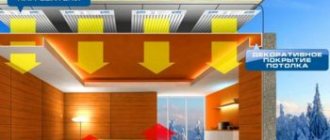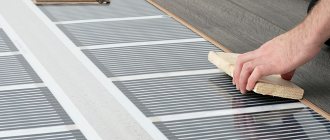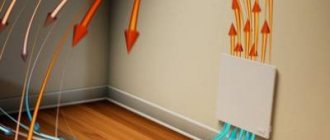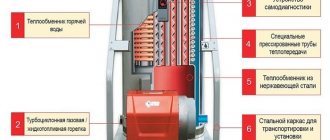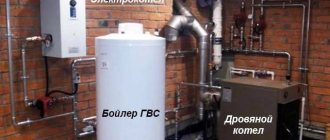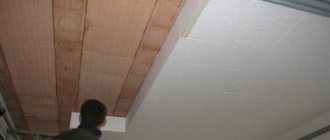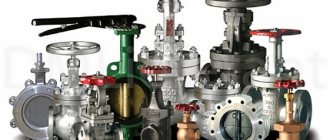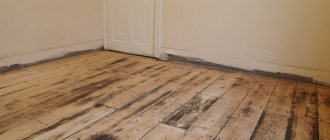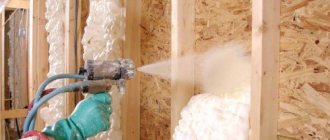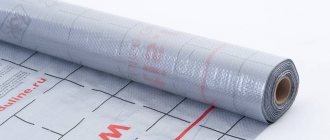Today, everyone can afford to have a warm floor in their apartment. For these purposes, the market offers a huge variety of different types, as well as all the necessary equipment, mixtures, and materials. Innovative technologies make the use of this type of heating more and more reliable and durable, masonry methods are simpler, and even a person without experience can often handle the installation.
In itself, this type of residential heating has many advantages:
- No drafts. A warm floor in a Khrushchev building is a real salvation, and in modern buildings a necessary condition for the comfort of the people living in it. Due to constant heat transfer, an unpleasant chill will no longer pass through your bare feet, which is especially important in the bathroom and nursery.
- Natural heating. Heat rises from bottom to top, which provides the human body with the most natural warming possible.
- Aesthetics. If necessary, you can completely abandon radiators.
- Even heat distribution. Some types of flooring can be positioned to compensate for cooling from external walls, windows and balconies.
- Durability. With proper installation, heating an apartment with warm floors can be carried out without problems for more than ten years.
- No dampness. This item is especially relevant for the bathroom, as it allows you to solve the problem of fungus and mold.
Taking into account all of the above, the answer to the question of whether a warm floor is needed in an apartment is obvious. Its use will allow you to effectively fill your home with heat, while maintaining the uniformity of its distribution.
Read on in the article to find out what types of heated floors there are in an apartment and about their features.
Warm floors: a brief overview
The modern consumer has a wide choice, since heated floors for an apartment can be made in different ways. At the moment, there are the following options for heated floors in the apartment:
- water;
- electrical cables;
- electric infrared.
From an installation point of view, infrared (film) ones are considered the simplest, since they require almost no preliminary preparation, while preliminary work for water floors can take up to a week.
Installation stage of water floors
Each of the above types will be discussed in more detail below.
Features of operation of underfloor heating
Before each heating season, it is necessary to check the integrity of system components. Almost all reviews of underfloor heating indicate a large amount of dust and dirt in the niches. They should be cleaned periodically.
Prevention of duct convectors
During operation, the thermostat parameters may change. Since it will be hidden behind a decorative grille, it is necessary to check its condition. Otherwise, the likelihood of system malfunction will increase. In addition, the integrity of the connection of the water heated floor to the heating system is monitored. In such schemes it is difficult to control the occurrence of leaks.
In models with a fan, the power line is laid in advance. To improve comfort, it is recommended to make a remote switch. Clogging of the fan rotor is also common. It must be cleaned before each heating season.
The video shows an example of installing a duct convector in an apartment:
Water floor: advantages, disadvantages, installation
Heated water floors in an apartment are a high-quality source of heat that will ensure heating of the entire room or living space.
Such a system is connected to central heating or to a boiler (if we are talking about autonomous heating).
Among the advantages are:
- Long service life. Provided proper installation and high-quality pipes - over 50 years of trouble-free service.
- Cooling compensation. Heating the walls in the apartment with warm floors laid in a special way will avoid temperature differences.
- Soft warm-up. Unlike other types, the room heats up gradually.
Schematic representation of temperature distribution
Installing heated floors in an apartment, however, will be accompanied by a number of difficulties:
- resolving legal and documentation issues;
- long preparatory work;
- selection of pipes taking into account the operating characteristics.
The most problematic is obtaining permission to install a water floor. This issue will be discussed at the end in a separate section, since it concerns not only this type.
The installation process itself consists of several stages:
- Preliminary. Surface preparation and leveling.
- Basic. Laying pipes, installing equipment.
- Final. Filling with the final screed, laying the floor covering.
During preliminary work, the most important thing is to level the floors. Most often, a special self-leveling solution is used.
It is extremely important to ensure that before installing heated floors in the apartment, the surface is not inclined - this will significantly complicate the functioning of the system.
Thermal insulation is laid on top of the frozen screed:
- rolled foil insulation;
- polystyrene foam mats;
- liquid solidifying mixtures with a heat-insulating effect.
It is necessary in order to increase the efficiency of heat transfer, and also to prevent neighbors from complaining about the warm ceiling.
Before installing heated floors in an apartment, a fixing layer is laid - it is on it that the pipe will be fixed. For these purposes you can use:
- fixing brackets;
- mounting grid;
- profile mat.
The second option is most often used, since it is accessible, easy to install, and at the same time greatly simplifies the laying of pipes. However, recently a third option has been gaining popularity.
Pouring the final screed over the profile mat
This effect is due not only to the gradual reduction in cost of the material from which it is made, but also:
- no need to lay thermal insulation;
- convenience;
- multifunctionality.
The latter refers to the possibility of both laying pipes in special recesses of the mat and using its relief for laying heat-conducting plates.
Using thermally conductive plates for installation
These plates are another way to install underfloor heating in an apartment and increase its efficiency. They are installed either on profile mats or on leveled wooden structures, and a pipe is laid in a special trench in the middle. The plate heats up from it and distributes heat evenly throughout the floor covering.
Next comes the installation of mixers, filters, thermostats and other necessary equipment. After checking the functionality of the system, it is filled with the final screed.
It is important to note that for water floors, metal-plastic or plastic pipes are recommended.
Warm cable floors: features and installation
If you need a warm floor under the tiles in your apartment, or it is not possible to install a water one, then an electric floor based on a cable will be the solution. Its arrangement will cost much less, and the efficiency will be no worse. Positive features of this type include:
- Availability. Anyone can afford to buy a cable or mats;
- Easy installation. Even a person without experience can lay such a floor.
- Uniform heating. Unlike cooling water, the heated cable has the same temperature along its entire length, which eliminates the presence of cool areas of the floor.
- Precise temperature control. Using a thermostat, you can accurately set the desired degrees.
- Warm-up speed. This floor warms up much faster - within 20 minutes it will reach its maximum temperature.
The only significant drawback is the high power consumption, as well as the need to install separate wiring.
Rolled heated electric floor
Answering the question of how to make heated floors in an apartment based on cable, three stages should be distinguished:
- Preparation. Thermal insulation, fixing mesh. It is not necessary to level the surface.
- Installation. Installing cable or laying mat.
- Finishing work. Filling with screed.
As mentioned above, thermal insulation is necessary to improve the efficiency of the system. You can do without it if there are no neighbors below and heat loss does not bother the owners. However, it is highly recommended to do so.
A fixing mesh is laid over the thermal insulation. This is where the cable will be attached. In this case, it is important that the latter is solid: there are no breaks, adhesions, or damage to the insulation.
Electric mats can be used as an alternative. In appearance, they are longitudinal tracks of a fixing mesh with a cable already laid. Efficiency is no different.
Next, the floor is connected to control and control devices. Modern thermostats can not only monitor the temperature, but also turn the floors on and off at a given time. A cement-sand mortar is poured over the laid layers.
Before connecting the heated floor in the apartment, you must wait until the screed has completely hardened.
Electrical system in the form of heating mats
A type of wired option. A heating mat is a thin heating cable that is fixed to a fixing base, presented in the form of a fiberglass mesh with a certain pitch. This design is intended for installation under the finishing floor covering in a layer of tile adhesive.
Pros:
- ease of control;
- easy installation.
Minuses:
- price;
- electricity costs.
Materials with high thermal conductivity, including ceramic tiles and natural stone, are used as finishing floor coverings.
When installing mats, no screed is installed. They can be laid on old flooring.
Infrared floors: characteristics and installation
How to make a heated floor in an apartment if it is not possible to carry out global repair work? The way out will be infrared heated floors. They are even less demanding to install and, in fact, plug into an outlet. Film heating systems were originally developed as a product that even a person without experience can handle.
They work due to graphite inserts located in a special film. These inserts generate heat due to infrared radiation, which is why the entire system got its name.
Roll of infrared film heated floor
The advantages of the type include:
- Variability of sizes. You can buy a small rug for your feet, or you can buy walkways to heat the entire room.
- Easy to install. This covering can be laid over the old floor.
- Price. One of the cheapest types.
- Long service life. Unlike water and cable analogues, this system requires little repair: if one strip fails, the others will continue to function.
The disadvantage, like its predecessor, is electricity consumption.
Film floor installation process
The installation process is similar to the cable type with one exception: if necessary, you can lay a film heated floor directly on top of the old floor covering.
Types of floor heating convectors
At the first stage of design, you should choose the right heating radiator built into the floor. They differ not only in standard power characteristics, but also in design. The material of manufacture is also important.
Duct radiator design
First, the required power is calculated. The basis is the heat loss in a house or apartment. Then the optimal model of the floor heating convector is selected.
It must have the required performance characteristics - withstand the rated pressure and temperature of hot water.
For installation, you will need to do preparatory work with a rough coating. Effective heating in the floor with your own hands is done only after insulating the rough surface.
The choice of installation diagram largely depends on the design of the floor radiators. They come in the following types:
- Floor mounted . They are located directly on the surface. The advantage is the simple connection of the water heated floor to the heating system. Pipes can be placed on top of the wall. Disadvantage – unsatisfactory appearance;
- Embedded . They are mounted directly into the floor on a rough surface. Only the grating remains in the visible region. Installation of heating in the floor is complicated, as this leads not only to a decrease in the height in the room, but also to the mandatory adaptation of the materials used to high temperatures.
Schemes for water floor heating in an apartment with wall-mounted models are not considered. They are no different from standard ones and have the same properties.
To increase the degree of convection, a fan can be included in the package. This will improve uniform heat distribution throughout the room. However, the cost of such models differs greatly.
Currently, there are a number of manufacturers whose products are suitable for DIY water floor heating. First of all, we should highlight the convectors of the German company Kampmann. Depending on the required parameters, heating convector models built into the floor may have two or three pipes. In the latter case, the rated power of the device increases.
Models of heating radiators built into the floor from the Polish company Verano, the Czech Minib and the German Kermi have no less good performance properties. To organize budget heating in the floor with your own hands, you can consider the products of the Ukrainian company Teplobrend and Carrera.
An additional function of water floor heating in a private house can be cooling in the summer. To do this, you need to connect to the chiller system.
Issues of bureaucracy and legality
Before making floors in an apartment with your own hands, you must obtain permission from the relevant authorities. This is necessary for a number of reasons:
- Strength of floors. The floor in each apartment is designed for a certain load, and the additional weight that will give, for example. A water floor can increase the risk of an emergency.
- Admissibility of connection. If we are talking about central heating, then installing a floor will significantly reduce the pressure in the riser, even if an auxiliary pump is used - the whole house risks not receiving enough heat. The electrical network may also not be able to withstand the voltage.
- Cost accounting. Before installing heated floors in an apartment, it may be necessary to install meters.
Regarding water floors, the greatest chances of obtaining permission for installation are for apartments in new buildings located on the top floor (if the supply is from the bottom) or on the bottom (if the supply is from the top). This is due to reasons of economy.
If the planned heated floors in the apartment are electric, then the only obstacle may be weak wiring.
In any case, it is recommended not to break the law, since if the owner installed a heated floor in his apartment without approval, this is considered an offense.
Such an action is equivalent to unauthorized redevelopment. A fine for underfloor heating in an apartment will have a negative impact on your financial condition.
Are warm floors really necessary in apartments?
The cost of heated floors for a medium-sized apartment is far from small, and permission to have heated floors in an apartment is not so easy to obtain, and owners often have the question of how justified such costs are?
The key advantage of heated floors is their ability to completely replace traditional radiator heating. Even without this, they relieve the room from the problem of dampness, drafts, cooling, and make staying in the home more comfortable. Rational use will make even such energy-intensive options as cable electric floors quite acceptable. The ability to install such a system under almost any floor covering makes it universal, and the wide range of materials and equipment offered allows you to choose the best option in terms of cost.
It is impossible to say which heated floor will perform the heating function better in an apartment - it all depends on the specific case. What remains undoubted is the fact that more and more people prefer this heating method.
Radiators and heated floors
Rule #1
If it is possible to replace conventional radiators with heated floors of the same type, make the most of this opportunity.
Just pay attention to the phrase “ there is an opportunity .”
If you live in a standard apartment on a certain floor, then neither the neighbors nor the rules will allow you to replace the usual batteries with a water floor. This is prohibited by SNiP.
You will have to make either infrared or lay a heating cable or mats.
There are only two main reasons for the ban:
- such a floor is not allowed to be embedded in a central heating system
- and it should not be placed above any living quarters that are below you
But if you live on the ground floor, and no one lives below you and there are no electrical rooms, then go ahead. The same applies if you have a private home.
In all these cases, water floors will outperform radiators in all respects.
- Firstly, such heating has much better energy efficiency
This means that it can heat a larger area using less energy.
- Secondly, a warm floor evenly warms the air throughout the entire volume of the room. But the batteries heat the air only in their vicinity.
- Thirdly, when heating devices are not visible, because they simply are not there, all rooms look much more aesthetically pleasing and beautiful
- Fourthly, it makes cleaning easier and there are no interfering batteries, pipes, outlets, etc.
Well, the most important thing is comfort. All radiators heat the air from the sides and above them. At the same time, the floor itself, including under the radiators, remains cold.
With radiators, you will move on a cold floor with temperatures up to 19 degrees, and your head will be located in a zone where it is more than 25 degrees. It’s impossible to call these comfortable conditions.
Of course, you can, as they say, fry the batteries to the maximum, but still you and your children will be forced to walk around the rooms in slippers.
More details
At the same time, you can forget about comfortable sleep in such a room. Moreover, even during the day it will not be entirely comfortable to be in it.
- first of all, it's too hot
- secondly, the air will be dry
But when the heating rises from below, from the floor itself, then much less temperature is required to warm up the entire room. This proves its effectiveness over other heat sources of the same type.
Thus, we can summarize the main conclusion of all of the above:
- water heated floor - better than standard radiators
- heating mats or cables are more effective than oil radiator batteries
- infrared floor - better than infrared heaters
